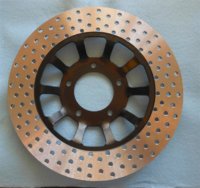EvenmoreXS
1981 XS650
Hello there forum members,
I am looking for a little assistance if you will. I have been searching for a printable template for drilling my front brake rotors in the pattern pictured below. I have found several links that have either been removed..they go nowhere... or are gone now for whatever reason, some that don't seem to print.. just links to images on photobucket. I hate to ask for help for this but I've wasted a lot of time and still haven't found the correct one. I know someone here can help. You guys rock.
Im not really interested in the swirl pattern unless there is a beneficial reason to do so, I think the 2-3-2 pattern below will look best on my bike.
If you have one, Id greatly appreciate you posting. If you have any other templates it wont hurt to add them here also, I named the thread something that will be very easy to find for other members in the future.
Thank you in advance.
I am looking for a little assistance if you will. I have been searching for a printable template for drilling my front brake rotors in the pattern pictured below. I have found several links that have either been removed..they go nowhere... or are gone now for whatever reason, some that don't seem to print.. just links to images on photobucket. I hate to ask for help for this but I've wasted a lot of time and still haven't found the correct one. I know someone here can help. You guys rock.
Im not really interested in the swirl pattern unless there is a beneficial reason to do so, I think the 2-3-2 pattern below will look best on my bike.
If you have one, Id greatly appreciate you posting. If you have any other templates it wont hurt to add them here also, I named the thread something that will be very easy to find for other members in the future.
Thank you in advance.





 I found it quite easy to drill my stock rotors. A little cutting oil, a sharp drill bit, and a low speed is all it takes.
I found it quite easy to drill my stock rotors. A little cutting oil, a sharp drill bit, and a low speed is all it takes.